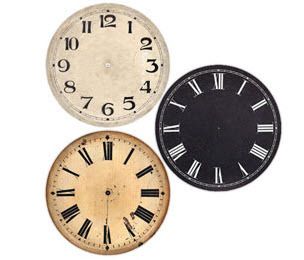Should Your Clock Parts be Digital or Analog?
 Some clock parts are digital, meaning that they make use of 7-segment displays to build 2 figures for the hr, 2 for the mins, as well as sometimes 2 for the secs. Other clock parts are analog, implying that they consist of electric motors, dials, as well as hands where traditional-looking timepieces are built. We intend to help you decide which way to go.
Some clock parts are digital, meaning that they make use of 7-segment displays to build 2 figures for the hr, 2 for the mins, as well as sometimes 2 for the secs. Other clock parts are analog, implying that they consist of electric motors, dials, as well as hands where traditional-looking timepieces are built. We intend to help you decide which way to go.
Digital clock parts tend to be uniform in appearance, the only variety being in terms of style, color, and size. On the other hand, you can invest all the time sorting via the wide variety of analog parts.
Diversities abound for the latter, based on a long history of making clocks. Many different societies have affected a broad variety of styles in clock dials and hands. Characters, untethered to the 7-segment pattern, are free to be Arabic, Roman, or symbolic.
One could also argue that the two types differ subtly yet distinctly in terms of exactly what customers get out of a layout and also quality viewpoint. People often look at an analog clock a lot more positively, paying equal focus to the look and also craftsmanship as they pay to performance. The digital clock is viewed virtually specifically for function.
Now, from the point of view of accuracy, electronic clock activities do a much better task of keeping time. Analog activities make use of tiny quartz crystals to obtain their timing, and they could drift by as much as 20 seconds a month. Still, this isn't bad in absolute terms.
But the digital parts are just that much a lot more precise. The timing resource might not be qualitatively much better compared to a quartz crystal, but electronic subdivision making use of mathematical computer signs up is much more accurate than the mechanical technique. At the luxury of the digital range are the so-called atomic clocks that utilize radio signals sent by a national standards center in Colorado to integrate down to the millisecond.
We are beginning to put together a listing of criteria for contrasting analog clock parts with electronic. We first talked about appearance and also then reliability. We now get to special attributes and expansions not only to conventional timekeeping yet also past it into other kinds of informational display screens. Unfortunately there is usually no basis for unbiased comparison in this department.
Analog and also digital parts both communicate easy timekeeping rather sufficiently. By this we mean showing minutes and hours in a 12-hour cycle (the most usual kind of clock). Revealing secs may be left out or included, with the digital version using 2 more 7-segment displays and the analog version using a pre-owned (ticking or continuous sweep).
To obtain 24-hour cycles is not a problem with electronic parts (you simply alter a setting). But when utilizing analog parts you have to trade the 12-hour dial with a 24-hour dial. This in turn needs a different clock activity that cycles two times as slowly (the hr hand traversing the circle once a day rather than two times a day).
Likewise, it calls for a special movement, special dial, as well as extra hand to reveal the date in a 31-day calendar month or the day of the week. These are timekeeping extensions you could attain with analog parts, as well as their effect is typically quite striking. These very same functions are feasible to realize digitally (and off-the-shelf clocks commonly offer them), though it may be hard for a specific to find the parts to accomplish it via assembly.
The same discrepancies apply to revealing non-temporal information, typically weather-related in some manner. Common examples are temperature and barometric pressure. A somewhat more exotic example for appear coastal regions is the screen of tide degree.
You could find digital clocks that consist of a thermometer and even a barometer, however it is unlikely you could track one down that shows the tide. It ares less likely that you would have the ability to assemble such a clock yourself from digital parts.
Nevertheless, the analog globe does supply such parts. Don't count on finding integrated weather and also clock movements, but you could get a dedicated face, hand, as well as movement for showing temperature, and a different combination of such parts for showing tide. This type of thing affords much possibility for imagination.
Alarm clocks are popular, and it should be instead straightforward to develop them from parts. Nonetheless, the alarm feature is practically exclusively component of an off-the-shelf, pre-assembled clock. (You may have much better luck in the electronic world than in the analog one.).
Chimes are another add-on attribute that is sometimes popular, though less so today than fifty to a hundred years ago. Grandfather and mantle clocks of yore used to play on the hour a tonal pattern, typically the Westminster or Whittington melodies, and follow it with an hour count. Chiming can be achieved with analog parts (with several options) but almost definitely not with electronic.
Pendulums were an essential element of mechanical clocks, but nowadays they are used solely for appearance or uniqueness. They are totally antithetical to electronic clocks, however some analog clock electric motors supply oscillating nodules to which cosmetic pendulums may be attached.
We wish that these comparisons have been helpful. Clockmakers obtain a lot of pleasure from developing something useful, attractive, and unique. You should now have the ability to identify whether your clock parts should be digital or analog.

